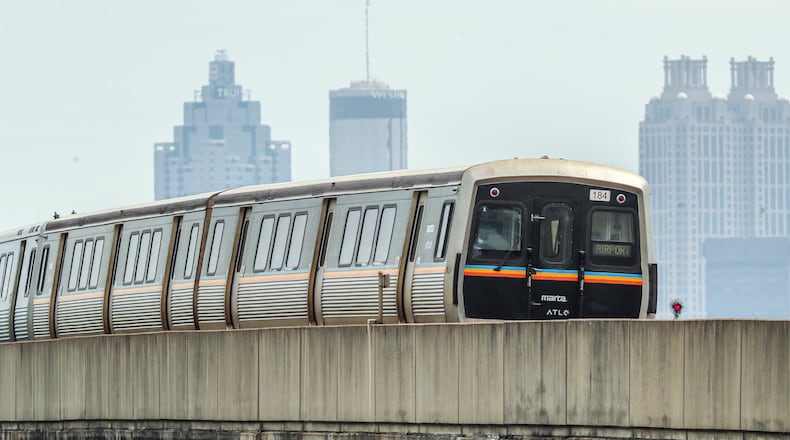Metro Atlanta’s improved smog levels allowed the area to meet federal standards for ozone pollution by a critical 2021 deadline — but just barely, according to recent data from state and federal environmental regulators.
The Atlanta area squeaked into compliance thanks in part to a dramatic drop in ozone pollution, otherwise known as smog, in 2020, when pandemic lockdowns decreased vehicle traffic.
Metro Atlanta’s air quality has improved significantly over the past two decades. Before 2020, the region still experienced several days each year with dangerous air quality readings that can be harmful to children, pregnant women and people with pre-existing conditions.
The “Atlanta area” as defined by the U.S. Environmental Protection Agency includes the counties of Bartow, Clayton, Cobb, DeKalb, Fulton, Gwinnett and Henry. The agency’s assessment that Atlanta met its standards was based on three years of data from 2018 to 2020.
Karen Hays, Georgia’s top air protection official in the Environmental Protection Division, celebrated the news.
“Air quality in the Atlanta Area continues to improve and EPA’s announcement is more evidence of that improvement,” Hays said in an email to The Atlanta Journal-Constitution.
She credited lower emissions from newer cars and trucks, as well as increased teleworking. Hays added that 2021 and 2022 have continued to show improvement in smog levels. That is despite an easing of pandemic restrictions and increased traffic since 2020.
Credit: AJC file photo
Credit: AJC file photo
Hays said areas of the U.S. that are unable to meet federal standards are required to use reformulated gasoline, which burns more cleanly and is “more expensive than the gasoline we use in Georgia.”
Despite meeting EPA standards, the Atlanta area still earned an F from the American Lung Association in a recent report the non-profit published using data from the same three-year period. The association does not use the same geographic boundaries as the EPA. Rather, it uses the census’ “combined statistical area” for Atlanta, which includes 42 counties, 10 of which had ozone pollution data.
Kevin Stewart, the director of environmental health with the American Lung Association, said his organization and regulators use the same monitoring data but different methodologies to calculate risk.
The EPA calculates its averages using fourth highest readings, which reduces volatility in the data. This is useful for an agency that helps determine regulations for industries and governments, Stewart said.
The American Lung Association counts the number of days considered unhealthy according to the Air Quality Index, the government’s official tool for reporting daily air quality.
Because Atlanta was borderline, Stewart said, it was a rare case where the association failed an area the EPA deemed to be in compliance.
“When you actually look at the numbers, you see that there’s not a lot of difference between what we consider an F and what the EPA considers attainment,” Stewart said. “Whereas the EPA takes an averaging approach, the Lung Association recognizes that people don’t breathe average air, they breathe whatever is in the air at the time they’re breathing it.”
The ALA ranked Atlanta the 51st most polluted city for smog, or ozone pollution, in its 2022 State of the Air report, an improvement of 16 places compared to the previous year. It ranked 37th for year-round soot, also known as particle pollution, moving up six places.
The report concluded Atlanta has the fourth poorest air quality in the Southeast.
The EPA declined to make a subject matter expert available for an interview and referred questions to Georgia officials.
Ozone pollution or smog is created by chemical reactions that occur in the presence of sunlight and warm temperatures. Emissions from burning fossil fuels in vehicles and power plants account for a large portion of ground level ozone pollution.
These emissions also contribute to the greenhouse effect that is warming the planet, which in turn creates the conditions for more ozone pollution. EPA researchers expect climate change to have a negative effect on air quality across the U.S. in years to come.
Children are particularly vulnerable to ozone pollution, as are people with asthma, older adults and outdoor workers.
Dr. Stanley Fineman, an allergist with Atlanta Allergy and Asthma, said ozone pollution makes people sick by causing inflammation in the airways.
“It can cause people to have breathing problems because it can cause swelling in their airways and narrowing in the airways,” he said. “It’s clearly damaging to the patient’s lungs.”
Fineman said he wasn’t surprised by the drop in smog since the onset of the pandemic, which saw temporary lockdowns and a lasting shift for some professions to remote work. He pointed to the dramatic decrease in children’s emergency room visits for asthma during the 1996 Summer Olympics, with the Centers for Disease Control and Prevention linked to reduced vehicle emissions.
“Pollution, I mean, obviously, that’s a real significant problem for our patients who have lung disease,” Fineman said. “Reduction in driving is clearly associated with reduction in pollution.”
A note of disclosure
This coverage is supported by a partnership with 1Earth Fund, the Kendeda Fund and Journalism Funding Partners. You can learn more and support our climate reporting by donating at ajc.com/donate/climate/
About the Author
Keep Reading
The Latest
Featured



